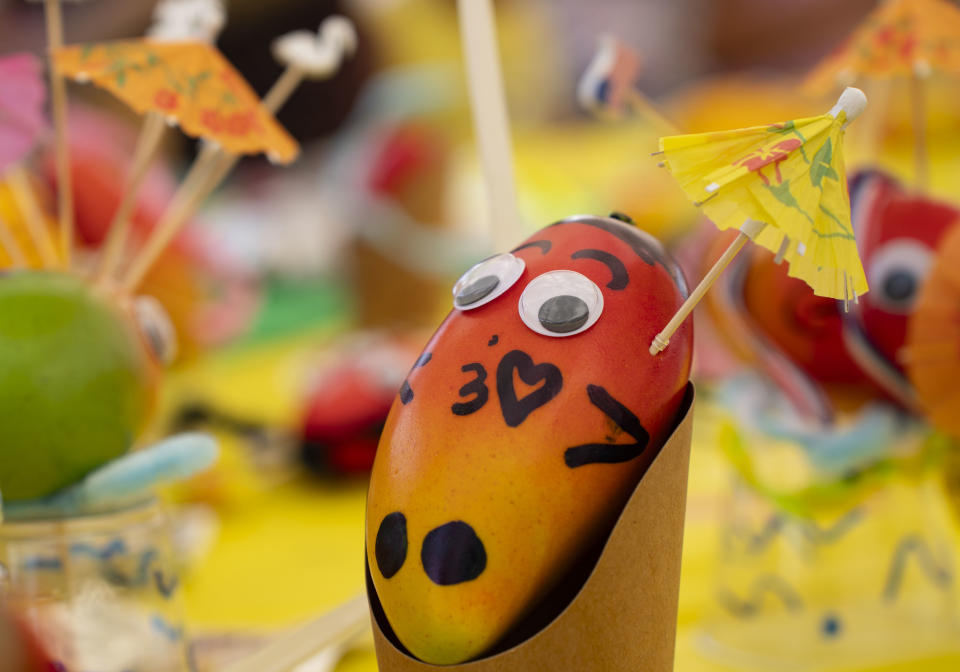Hurricane Ian took Southwest Florida’s mangoes. People still celebrated the mango festival.
Pine Island is Southwest Florida’s largest barrier island, but it’s not a place that tourists generally seek out. There are no sandy beaches or luxury apartments, but it is prized by a local fishing community and loved for another thing — the abundant mangoes featured during the island’s signature mango festival.
The festival this year was July 15. That day, David Etscovitz trudged across his 15-acre fruit grove on the island. Even though it had just rained, each step kicked up dust.
“Where is it?” he said with a hint of frustration, surveying his 300 mostly bare, nearly century-old trees.
He finally stopped below an uncommonly tall and sturdy one.
“This is like the only mangoes in the whole grove,” he said, “Right here.”
He pointed to a cluster of about a dozen round, ripe fruit with his missing right index finger, lost in a woodworking accident decades ago. He swears the 46 goats that share the property the Connecticut native bought with a dream of selling fresh produce had nothing to do with it.
The mangoes hung from spindly branches without leaves, high above the ground.
Though they’re planted 30 feet apart, the trees normally provide a full canopy of shade while Etscovitz and his wife, Carol, work in the field.
“As you can see, they’ve all been blown apart,” he said.
Hurricane Ian made landfall just 5 miles away in September with 160 mph winds and a storm surge that swallowed shorelines and buildings and, for more than a week, left Pine Island without the only bridge connecting it to the mainland.
Reminders of the storm remain everywhere, but this first summer after Ian, Pine Island residents say an obvious one is the lack of mangoes.
Last year, Etscovitz sold boxes of fruit and welcomed festival attendees to his farm, Promised Land Mangoes. This year he declined to participate.
“We’ve been dead in the water for a year,” Etscovitz said. “It hurts.”
No mangoes, no problem
Earlier that day, MangoMania, Pine Island’s 27th annual mango festival, drew more than 70 local businesses and nonprofits, including fishing apparel vendors, jewelry-makers and environmental advocates. But the root of the celebration, Pine Island’s mango growers, were mostly missing.
Just one island grove opened a stall, but could only sell mangoes brought from Miami, Naples and Orlando. Of the four fruit vendors present, only two represented local farms.
The Mr. Mango Head booth, a tropical twist on the children’s toy, had to substitute spray-painted, Styrofoam replicas for real mangoes due to the fruit’s scarcity. The mango crowned this season’s largest, at 3½ pounds, was more than a pound lighter than normal. The number of competing entries dropped from a peak of 25 to only three.
Because he had no mangoes to sell, one farmer instead gave a seminar teaching people how to pick the perfect mango. The CliffsNotes: It takes years of practice to properly trust your mango instincts.
Still, vendors peddled mango cocktails, essential oils and plants from cramped tents that littered the trampled turf. Locals traversed the festival grounds barefoot, evading spiny pine cones and needles.
The hot sun beat down relentlessly. Another reminder of Ian, said Todd Combs, who owns Pine Island Auto Repair. The once-shady pines — which give the island its name — had been stripped.
“We all talk about Ian like it’s an ex,” one islander put it. “He ruined everything.”
But the joyful mango celebration went on, maybe even strengthening the sense of community.
One attendee drove 40 minutes to the festival in search of trees to replace the three Ian uprooted outside their house on Mango Street. A Pine Island local lowered the top on his BMW convertible to make room for a new sapling.
“We don’t let a little thing like a major hurricane get us down,” MangoMania organizer Cynthia Welch said.
Hope for a hurricane boost?
A hurricane brought mangoes to Pine Island to begin with. They were a replacement for the citrus crops that a 1950s storm rendered nearly uncultivable after salinating the island’s soil.
Pine Island’s soil is deep and well-drained — a boon to fruit trees — and the climate is ideal for large yields of mangoes.
It wasn’t the water from Ian — Pine Island’s gulfside mangroves protected many of the island’s fruit trees from the saltwater intrusion — that damaged soil and left other green barrier islands looking brown and withered. It was the high-speed wind that ripped off branches.
“Less wood, less volume, less fruit,” said Stephen Brown, horticulture agent for the University of Florida’s Lee County research branch.
MangoMania organizer Welch, who did not harvest a single mango from her own grove of 20 trees this year, said all of her barren trees survived the storm. But one very nearly didn’t make it.
“Let’s put it this way: It’s now a mango bush,” she said.
Some are hopeful though, that the hurricane could once again prove a boon to Pine Island’s now-signature fruit, as it did in the ‘50s. There are rumblings of a bumper crop next year. Mangoes grow on the previous year’s growth, and after a hurricane naturally prunes the tops of trees, that growth can happen rapidly.
Though that’s far from certain, farmers won’t give up.
Treehouse Farms owner Jay Reynolds said his 100 trees only netted a single box of fruit this year.
“It’s my passion,” said Reynolds when asked why he picked such an uncertain career. “And I don’t have to pay for a gym membership.”
Carol Etscovitz, who took over Promised Land Mangoes with her husband two years ago, said they’re counting on next year.
“We just got in,” she said. “We’re not leaving.”




